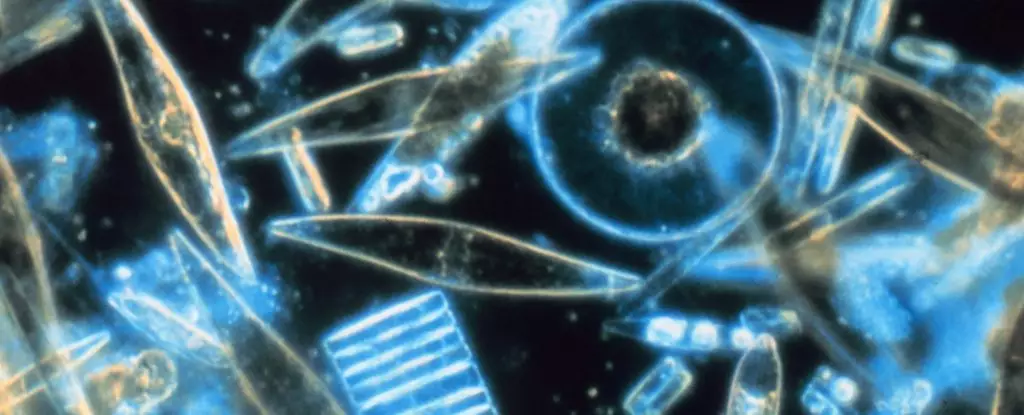For decades, scientists have held the belief that the remote southernmost waters of the globe are primarily a cold, barren expanse, playing a limited role in the Earth’s carbon cycle. This assumption rooted itself in the challenging nature of these icy reaches—hard to access, poorly understood, and often dismissed as irrelevant in global climate models. Yet, recent groundbreaking research throws this narrative into question, hinting at a far more complex, and arguably more alarming, reality. What appears to be a tranquil turquoise patch within the Southern Ocean’s icy expanse might in fact be a manifestation of a profound ecological deception—one that calls into question our understanding of how carbon is absorbed or released in these frigid waters.
This revelation exposes the danger of complacency rooted in assumptions. It underscores how much we still don’t grasp about the planet’s most remote ecosystems. Assuming that cold equates to inactivity or insignificance is not just naive—it’s a dangerous oversight that could hamper climate mitigation efforts. In fact, these recent insights suggest that the southern ocean’s role as a carbon sink is more nuanced, perhaps even more volatile, than previously believed. The revelation invites us to scrutinize our models carefully, recognizing the peril of blind trust in satellite data that might be deceiving us due to complex optical phenomena.
The Illusion of the Bright Blue: A Closer Look at Oceanic Microbial Mysteries
The glowing turquoise hue that has puzzled scientists for years isn’t just an aesthetic oddity—it’s a window into the intricate biological processes occurring beneath the surface. For a long time, oceanographers thought this coloration was a signature of coccolithophores—tiny, sunlight-loving protists that build calcite shells and are known to influence atmospheric CO₂ levels significantly. However, recent direct measurements suggest that these microorganisms are not as prevalent in these cold, southern waters as satellite imagery has implied. Instead, diatoms—another type of microscopic alga with silica shells—may be responsible for much of the visual brightness and reflectance seen from space.
This misinterpretation serves as a cautionary tale about overreliance on remote sensing technology without sufficient ground-truthing. Satellites provide invaluable data, but they are limited to a shallow view—merely the uppermost layers of the ocean. The real story is often hidden beneath, within the depths of biological and chemical interactions that cannot be captured from space. What was once thought to be high concentrations of calcite-producing microbes might instead be a dense proliferation of diatoms, which, while different in their chemical signatures, produce similar optical effects. This misidentification strips away the assumption that the southern polar waters are a refuge for calcite-producing organisms, revealing instead a landscape dominated by silica-based life forms.
Challenge to Established Paradigms and the Shift in Scientific Understanding
This discovery should serve as a wake-up call, exposing the fragility of our scientific paradigms, especially when it comes to understanding global biogeochemical cycles. The previous model presuming coccolithophores dominate these southern waters now falters; in their place, diatoms emerge as key players. The implications are profound. Diatoms are often associated with high productivity and rapid carbon sequestration, but if their populations are flipping from a minor to a dominant role in these cold environments, then the dynamics of carbon absorption and release are shifting unexpectedly.
These findings cast doubt on the accuracy of satellite-based estimates concerning inorganic and organic carbon fluxes, forcing scientists to reconsider how they interpret ocean color data. If diatoms are responsible for the high reflectance previously attributed solely to coccolithophores, then the role of these vast, cold ocean expanses in sequestering atmospheric CO₂ may be overestimated or misunderstood altogether. This gap in understanding hampers our ability to make precise predictions about climate change impacts, especially in regions thought to be less significant in the global carbon budget.
The potential reevaluation of how the southern ocean functions as a carbon sink triggers broader questions about the resilience and vulnerability of marine ecosystems amid climate change. Are these ecosystems shifting because of temperature changes, melting ice, or other anthropogenic factors? Or is this part of an ongoing, natural fluctuation? Regardless, the new evidence underscores the critical need for targeted, ground-based research to push past the limitations of satellites and delve deeper into these enigmatic waters.
Implications for Climate Policy and Global Awareness
Understanding and accurately modeling the behavior of these polar waters is not an academic exercise—it has direct, tangible consequences for global climate policy. Mischaracterizing the region’s role in carbon sequestration may lead to flawed policies, either overestimating our ability to rely on the ocean as a carbon sink or underestimating its vulnerability to rapid change. If recent research indicates that ocean productivity and carbon cycling are more dynamic and susceptible to shift than assumed, then climate strategies must be recalibrated accordingly.
This situation demands a shift toward more integrated research approaches—combining satellite data with oceanic expeditions, chemical analyses, and biological understanding. Only through such comprehensive efforts can we gain a truthful picture of these ecosystems. Fundamentally, these discoveries challenge us to think more critically about what we consider “truth” in environmental science, especially when that truth influences policy decisions affecting millions. It also highlights the importance of humility in scientific pursuits; the ocean’s depths are far more mysterious and interconnected than our current models acknowledge.
The revelations about the southern ocean are a stark reminder that science is a constantly evolving field. The answer to these puzzles is unlikely to come from satellites alone, and the urgency to invest in deep-sea research should increase. Our climate outlook depends on acknowledging the unknowns, correcting our misconceptions, and embracing a more nuanced understanding of Earth’s complex, living systems.


Leave a Reply